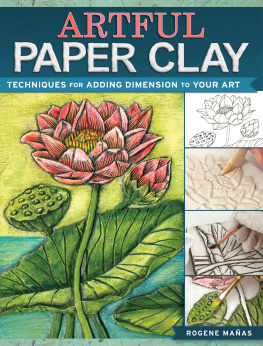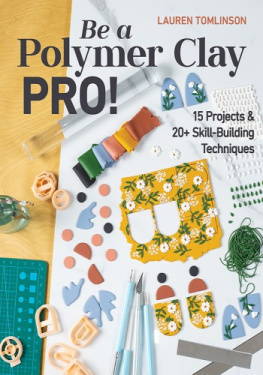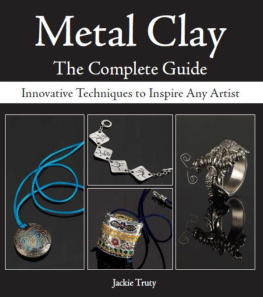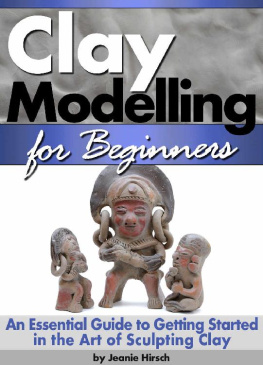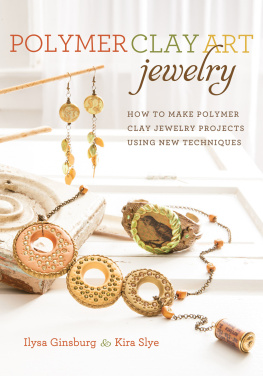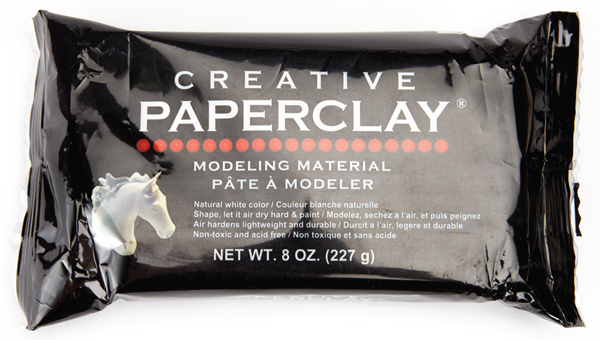Thank you for purchasing this Artist Network eBook.
Sign up for our newsletter and receive special offers, access to free content, and information on the latest new releases and must-have art resources! Plus, receive a coupon code to use on your first purchase from NorthLightShop.com for signing up.
or visit us online to sign up at
http://artistsnetwork.com/ebook-promo
Dedication
To my mother, Bruna Marie Manas, who died from Alzheimers disease in the summer of 2004. In the week that followed her death, I created a portrait of her as a child, my first paper clay bas-relief. It was born from an idea Id never had time to pursue. Thank you, mom, for being inventive, creative, frugal and resourceful. And for teaching me what your mother taught you: Never say cant.
To my husband, Rick, who is the most supportive, encouraging, loving, kind, honest, helpful and entertaining husband an artist could want.
To my son, Geno, and my daughter, Aja, who inspired me to work hard to become my best self. And who are truly my greatest works of art.
And to everyone who has liked my work, purchased my art, taken my workshops or given me an encouraging word. Thank you all so very much.
Contents
CHAPTER ONE
CHAPTER TWO
CHAPTER THREE
CHAPTER FOUR
Introduction
STAY AT HOME DAD
Paper clay and mixed media on canvas
12" 9" (30cm 23cm)
As a mixed-media artist, I am always experimenting with materials, tools and techniques. I am forever in search of fun and forgiving ways to make art. More than ten years ago, I began adding air-hardening clay to my paintings after a fellow artist introduced me to the paper clay she used in doll making. For me, it was love at first sight and the ultimate mixed-media material because it held detail, adhered to my boards and canvases, and could be used in conjunction with lots of other materials. Working with the clay is such an enjoyable process that I soon became addicted to it.
I began teaching workshops by popular demand. Once people saw my work, they wanted to know how it was made. My students quickly discovered how easy paper clay was to use and master. And now, years later, I have compiled this comprehensive book to share all the ways I have discovered to use paper clay in bas-relief. It adds a sculptural element to two-dimensional work that makes it jump right off the board.
This book is for the experimenter. Its for beginning and accomplished artists alike who are looking for new ways of creative expression. If youve tried different methods of making art and nothing has really grabbed you, or if you are new to art and just dont know where to begin, this might be your medium.
Paper clay is perhaps the most versatile medium I have ever used. And because it is first sculpted and then painted, it fulfills my desire to work in a variety of mediums on a single project. The process is enjoyable from start to finish, and the results are very rewarding. It has given me a new way to express my thoughts and feelings that was missing from my previous work. It adds a dimensional quality, which I adore, giving weight and presence to my ideas.
This book is divided into four sections: Working with Clay, Clay Work Projects, Finishing Techniques and Creative Projects. In section 1, you will learn all about working with clay in bas-relief and create several mini practice projects. Section 2 is composed of five complete demonstrations of clay projects. In the final sections, you will take your projects to completion. You will learn about working with color, painting with acrylics and applying mediums and collage materials. In addition, you will find cool paper clay project ideas, painting and collage techniques, and framing tips.
The entire experience of working with paper clay and finishing it can be a meditative, yet enlivening process. You will discover a newfound freedom with art making because this process is a very flexible and forgiving one. Anything can be changed, reworked, patched, added to, removed, repaired and repainted. So relax and have fun with it. Let your creative spirit guide you and get out of your own way!
Tools for Clay Work
CREATIVE PAPERCLAY
Creative Paperclay is the brand of clay that I use in my clay work process. It is an air-hardening modeling material that requires no firing or baking and comes out of the package ready to use. It is clean, nontoxic, odorless, dries with minimal shrinkage and is fairly durable when varnished. Plus, when wet, it sticks to almost anything without the use of glue, making it ideal for bas-relief work. You can purchase the clay in 4, 8 and 16 ounce packages. Most step-by-step projects in this book will require about 2 to 4 ounces of clay. Creative Paperclay is available in most craft and art supply stores as well as online.
OTHER AIR-HARDENING CLAYS
Though I use Creative Paperclay and am most familiar with using it for this process, there are other clays that work in a similar way, such as La Doll modeling clay, La Doll Premier Light Weight Stone Clay and Fimo Air Basic. For my descriptions about each of these alternative clays, see the resources section for more information.
WOODEN SCULPTING TOOLS
Though there are many kinds of tools for clay modeling, I use one kind of tool for most of my work, a simple wooden sculpting tool. Wooden tools glide over the clay more easily than plastic ones and have a more natural feel. Plus they can be cut and sanded to be smaller, sharper or smoother depending upon what is needed. The shape, which includes an angle with a point, is very important for sculpting bas-relief on flat surfaces. Commercially, my preferences are the models JA22 and JA24 wooden tools made by Kemper Tools. They are relatively inexpensive and if you buy two or three, you can customize them to suit your needs. Because they are all handmade, they will vary a bit in shape. Sand them with fine-grain sandpaper to be sure they are smooth and that the angled edge is sharp.
OTHER MODELING TOOLS
Plastic, rubber and silicone clay modeling tools are great for shaping, making detail marks and cleanup work. There are several synthetic-tipped modeling tools available on the market that range from hard and firm to soft and flexible. They yield a variety of effects and are generally more expensive than wooden tools. Art supply and craft stores often carry sets of clay shapers made from rubber or silicone that work well for bas-relief. For detail work and cleaning up edges and backgrounds I use a hard rubber-tipped tool called a Wipe Out Tool by Art Advantage.

